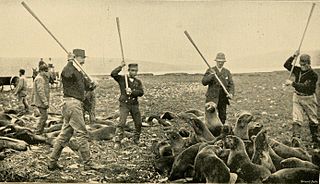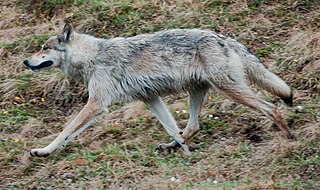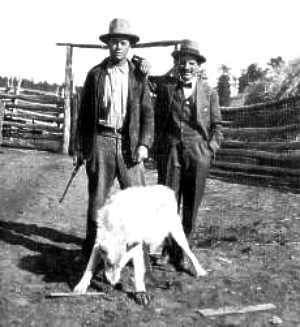
The coyote is a species of canine native to North America. It is smaller than its close relative, the wolf, and slightly smaller than the closely related eastern wolf and red wolf. It fills much of the same ecological niche as the golden jackal does in Eurasia. The coyote is larger and more predatory and was once referred to as the American jackal by a behavioral ecologist. Other historical names for the species include the prairie wolf and the brush wolf.

The wolf, also known as the gray wolf or grey wolf, is a large canine native to Eurasia and North America. More than thirty subspecies of Canis lupus have been recognized, including the dog, though gray wolves, as popularly understood, only comprise wild subspecies. The wolf is the largest extant member of the family Canidae, and is further distinguished from other Canis species by its less pointed ears and muzzle, as well as a shorter torso and a longer tail. The wolf is nonetheless related closely enough to smaller Canis species, such as the coyote and the golden jackal, to produce fertile hybrids with them. The wolf's fur is usually mottled white, brown, gray, and black, although subspecies in the arctic region may be nearly all white.

The Hokkaido wolf, also known as the Ezo wolf and in Russia as the Sakhalin wolf, is an extinct subspecies of gray wolf that once inhabited coastal north-east Asia. Its nearest relatives were the wolves of North America rather than Asia. It was exterminated in Hokkaido during the Meiji Restoration period, when American-style agricultural reforms incorporated the use of strychnine-laced baits to kill livestock predators. Some taxonomists believe that it survived up until 1945 on the island of Sakhalin. It was one of two subspecies that were once found in the Japanese archipelago, the other being the Japanese wolf.

Plains Indians or Indigenous peoples of the Great Plains and Canadian Prairies are the Native American tribes and First Nation band governments who have historically lived on the Interior Plains of North America. While hunting-farming cultures have lived on the Great Plains for centuries prior to European contact, the region is known for the horse cultures that flourished from the 17th century through the late 19th century. Their historic nomadism and armed resistance to domination by the government and military forces of Canada and the United States have made the Plains Indian culture groups an archetype in literature and art for Native Americans everywhere.

Seal hunting, or sealing, is the personal or commercial hunting of seals. Seal hunting is currently practiced in ten countries: United States, Canada, Namibia, Denmark, Iceland, Norway, Russia, Finland and Sweden. Most of the world's seal hunting takes place in Canada and Greenland.

Wolf hunting is the practice of hunting gray wolves (Canis lupus) or other species of wolves. Wolves are mainly hunted for sport, for their skins, to protect livestock and, in some rare cases, to protect humans. Wolves have been actively hunted since 8,000 to 10,000 years ago, when they first began to pose a threat to livestock of Neolithic human communities. Historically, the hunting of wolves was a huge capital- and manpower-intensive operation. The threat wolves posed to both livestock and people was considered significant enough to warrant the conscription of whole villages under threat of punishment, despite the disruption of economic activities and reduced taxes. The hunting of gray wolves, while originally actively endorsed in many countries, has become a controversial issue across the globe. Most people see it as cruel, unnecessary and based on misconceptions, while proponents argue that it is apparently vital for the conservation of game herds and as pest control.

The Eurasian wolf, also known as the common wolf, is a subspecies of grey wolf native to Europe and Asia. It was once widespread throughout Eurasia prior to the Middle Ages. Aside from an extensive paleontological record, Indo-European languages typically have several words for "wolf", thus attesting to the animal's abundance and cultural significance. It was held in high regard in Baltic, Celtic, Slavic, Turkic, ancient Greek, Roman, and Thracian cultures, whilst having an ambivalent reputation in early Germanic cultures.

Hunting in Russia has an old tradition in terms of indigenous people, while the original features of state and princely economy were farming and cattle-breeding. There was hunting for food as well as sport. The word "hunting" first appeared in the common Russian language at the end of the 15th century. Before that the word "catchings" existed to designate the hunting business in general. The hunting grounds were called in turn lovishcha ("ловища"). In the 15th-16th centuries, foreign ambassadors were frequently invited to hunts; they also received some of the prey afterwards.

Bear hunting is the act of hunting bears. Bears have been hunted since prehistoric times for their meat and fur. In addition to being a source of food, in modern times they have been favoured by big game hunters due to their size and ferocity. Bear hunting has a vast history throughout Europe and North America, and hunting practices have varied based on location and type of bear.

Wolf hunting with dogs is a method of wolf hunting which relies on the use of hunting dogs. While any dog, especially a hound used for hunting wolves may be loosely termed a "wolfhound", several dog breeds have been specifically bred for the purpose, some of which, such as the Irish Wolfhound, have the word in their breed name.

The history of wolves in Yellowstone includes the extirpation, absence and reintroduction of wild populations of the gray wolf to Yellowstone National Park and the Greater Yellowstone Ecosystem. When the park was created in 1872, wolf populations were already in decline in Montana, Wyoming and Idaho. The creation of the national park did not provide protection for wolves or other predators, and government predator control programs in the first decades of the 1900s essentially helped eliminate the gray wolf from Yellowstone. The last wolves were killed in Yellowstone in 1926. After that, sporadic reports of wolves still occurred, but scientists confirmed that sustainable wolf populations had been extirpated and were absent from Yellowstone during the mid-1900s.
Wolves were once present in Great Britain. Early writing from Roman and later Saxon chronicles indicate that wolves appear to have been extraordinarily numerous on the island. Unlike other British animals, wolves were unaffected by island dwarfism, with certain skeletal remains indicating that they may have grown as large as Arctic wolves. The species was exterminated from Britain through a combination of deforestation and active hunting through bounty systems.

Bison hunting was an activity fundamental to the economy and society of the Plains Indians peoples who inhabited the vast grasslands on the Interior Plains of North America, prior to the animal's near-extinction in the late 19th century following US expansion into the West. Bison hunting was an important spiritual practice and source of material for these groups, especially after the European introduction of the horse in the 16th through 18th centuries enabled new hunting techniques. The species' dramatic decline was the result of habitat loss due to the expansion of ranching and farming in western North America, industrial-scale hunting practiced by non-Indigenous hunters, increased Indigenous hunting pressure due to non-Indigenous demand for bison hides and meat, and cases of deliberate policy by settler governments to destroy the food source of the Indigenous peoples during times of conflict.

The Interior Alaskan wolf, also known as the Yukon wolf, is a subspecies of gray wolf native to parts of British Columbia, the Northwest Territories, Interior Alaska and Yukon.
The Siberian fur trade is an exchange concerned with the gathering, buying and selling of valuable animal furs that originate from Siberia. The Siberian fur trade expanded from localized trade, and Siberian fur is now traded around the world. The Siberian fur trade had a significant impact on the development of Siberia through exploration and colonization. The fur trade also precipitated a decline in the number of fur-bearing animals and resulted in Siberia being conquered by Russia.

The Custer Wolf was a North American gray wolf who was held responsible for extensive damage to ranchers' livestock in the area surrounding Custer, South Dakota, between 1911 and 1920, with the damage estimated at $25,000. The wolf was shot by a hunter employed by the federal government, who tracked the wolf for months and killed him after the wolf had triggered a trap.

Wolf distribution is the species distribution of the wolf. Originally, wolves occurred in Eurasia above the 12th parallel north and in North America above the 15th parallel north. However, deliberate human persecution has reduced the species' range to about one-third, because of livestock predation and fear of wolf attacks on humans. The species is now extirpated in much of Western Europe, Mexico, and the contiguous United States, and completely from the British Isles and the Japanese archipelago. In modern history, the gray wolf occurs mostly in wilderness and remote areas, particularly in Canada, Alaska, the Northern United States, Europe and Asia from about the 75th parallel north to the 12th parallel north. Wolf population declines have been arrested since the 1970s, and have fostered recolonization and reintroduction in parts of its former range, due to legal protection, changes in land-use and rural human population shifts to cities. Competition with humans for livestock and game species, concerns over the danger posed by wolves to people, and habitat fragmentation pose a continued threat to the species. Despite these threats, because of the gray wolf's relatively widespread range and stable population, it is classified as Least Concern on the IUCN Red List. In Africa the population of wolves is limited to the northern regions with the African golden wolf north of the Sahara and the Ethiopian wolf in Ethiopia.

The repopulation of wolves in Midwestern United States has occurred naturally as the gray wolf has expanded its territory after being nearly extirpated from the conterminous United States. The Midwestern states of Michigan, Minnesota, and Wisconsin are estimated to have 4,400 wolves. The western Great Lakes region they inhabit includes the forested areas of these states, along with the Canadian provinces of Manitoba and Ontario. In 1978, wolves were protected under the federal Endangered Species Act as it was determined that they were in danger of going extinct and needed protection to aid their recovery. Management under the Act allowed the remaining wolves in Minnesota to flourish and repopulate northern Wisconsin and the Upper Peninsula of Michigan. Wolves were removed from federal protection in January 2021 with management authority remaining with state and tribal authorities. Management plans guide each state's decisions about wolf regulations for hunting, trapping, and culling along with population monitoring, and livestock damage control. In February 2022, a judge ordered federal protections for gray wolves to be restored under the Federal Endangered Species Act which returned management authority to the U.S. Fish and Wildlife Service.
















